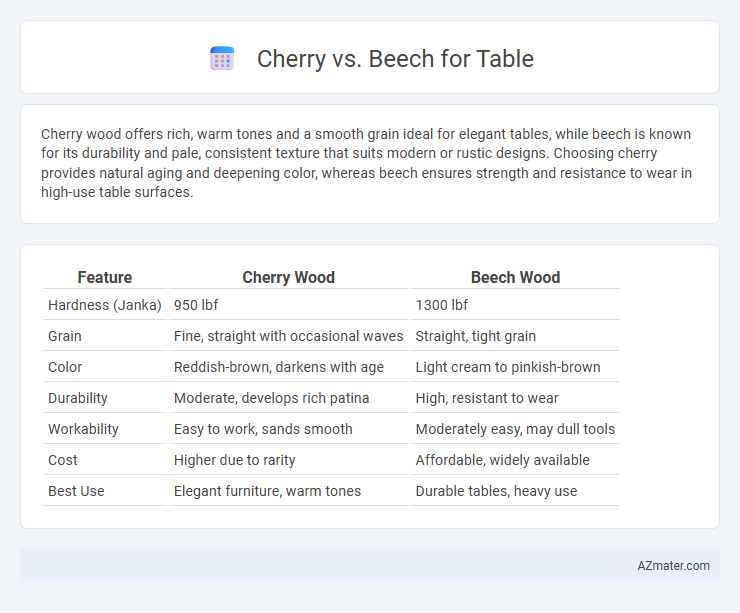Cherry wood offers rich, warm tones and a smooth grain ideal for elegant tables, while beech is known for its durability and pale, consistent texture that suits modern or rustic designs. Choosing cherry provides natural aging and deepening color, whereas beech ensures strength and resistance to wear in high-use table surfaces.
Table of Comparison
| Feature | Cherry Wood | Beech Wood |
|---|---|---|
| Hardness (Janka) | 950 lbf | 1300 lbf |
| Grain | Fine, straight with occasional waves | Straight, tight grain |
| Color | Reddish-brown, darkens with age | Light cream to pinkish-brown |
| Durability | Moderate, develops rich patina | High, resistant to wear |
| Workability | Easy to work, sands smooth | Moderately easy, may dull tools |
| Cost | Higher due to rarity | Affordable, widely available |
| Best Use | Elegant furniture, warm tones | Durable tables, heavy use |
Introduction to Cherry and Beech Wood
Cherry wood, prized for its rich reddish-brown hue and smooth grain, offers durability and elegant aging, making it a popular choice for fine furniture and tables. Beech wood, characterized by its pale cream color and tight grain pattern, is highly valued for its strength and resistance to wear, providing a sturdy and reliable surface for table crafting. Both woods exhibit excellent workability and finish qualities, but Cherry's warm tones contrast with Beech's lighter, more uniform appearance, influencing the aesthetic and functional appeal in table design.
Visual Appearance and Color Differences
Cherry wood exhibits a rich, warm reddish-brown hue that deepens with age, creating a luxurious and inviting table surface. Beech wood offers a lighter, creamier color with a subtle pink or yellow tone, giving tables a clean, bright appearance that complements modern decor. The fine, even grain of beech contrasts with the more pronounced, smooth grain of cherry, making each wood type distinct in visual texture and color depth.
Grain Patterns and Texture
Cherry wood features a fine, straight grain with occasional waves, offering a smooth texture that enhances its warm reddish-brown color over time. Beech wood exhibits a tight, uniform grain with a more consistent, slightly coarse texture that provides excellent durability and a pale, creamy appearance. Both woods are prized for their distinctive grains; cherry lends an elegant, flowing pattern while beech presents a subtle, even surface ideal for contemporary table designs.
Durability and Hardness Comparison
Cherry wood is moderately hard with a Janka hardness rating of approximately 950, offering good durability for indoor furniture but being softer than many hardwoods. Beech wood scores higher on the Janka scale at around 1300, providing greater resistance to dents and wear, making it more suitable for tables subjected to frequent use. The superior hardness and durability of beech contribute to longer-lasting table surfaces compared to cherry, which, while visually appealing, may show signs of wear more quickly.
Workability and Ease of Crafting
Cherry wood offers exceptional workability with its fine, straight grain and moderate hardness, making it easy to shape, sand, and finish for table crafting. Beech wood, while harder and denser, provides a consistent texture that responds well to cutting and turning but requires more effort during sanding and finishing. Both woods hold nails and screws securely, though cherry's natural oils enhance its resistance to wear and improve the ease of hand-tool use compared to beech.
Cost and Availability Analysis
Cherry wood tables generally command higher prices due to the wood's rich color and fine grain, making them a premium choice for upscale furniture. Beech wood, widely available and sourced sustainably, offers a more cost-effective option with consistent quality and durability. Market availability for cherry can be limited and region-dependent, while beech is commonly stocked by most hardwood suppliers, ensuring easier access and quicker turnaround times.
Maintenance and Longevity
Cherry wood requires periodic oiling to maintain its rich color and prevent drying, while beech demands less frequent maintenance but is more prone to dents and scratches. Beech's hardness makes it durable for everyday use, but cherry's natural resistance to wear and patina development enhances its longevity over time. Proper care of cherry tables, including protection from direct sunlight, significantly extends their lifespan compared to beech tables.
Environmental Impact and Sustainability
Cherry wood tables offer moderate sustainability due to their slower growth rate and longer harvest cycles, which require responsible forest management to minimize environmental impact. Beech wood stands out with faster growth and higher yield per acre, making it a more sustainable option for furniture production when sourced from certified forests. Both woods require sustainable harvesting practices to reduce carbon footprint and preserve biodiversity in their native habitats.
Best Uses for Cherry and Beech Tables
Cherry wood tables excel in rich durability and warm reddish tones, making them ideal for formal dining rooms and elegant office desks where aesthetic appeal and longevity are priorities. Beech wood tables offer a light, consistent grain and high shock resistance, perfect for modern kitchens and casual dining areas that require functional, hard-wearing surfaces. Both woods provide excellent stability, but cherry's natural aging process enhances its beauty, while beech maintains a sleek, uniform appearance over time.
Final Verdict: Which Wood Is Better for Tables?
Cherry wood offers a rich, warm tone with excellent durability and a smooth grain that deepens in color over time, making it highly desirable for elegant tables. Beech wood provides a lighter, more uniform appearance with strong resistance to wear and dents, ideal for modern, practical table designs. Choosing between cherry and beech depends on whether you prioritize aesthetic warmth and aging beauty or consistent durability and lighter color for your table.

Infographic: Cherry vs Beech for Table
 azmater.com
azmater.com